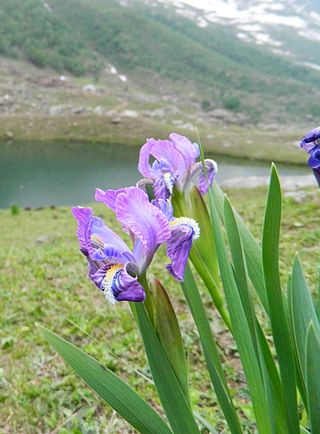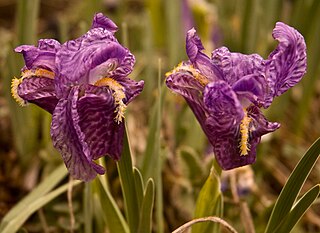
Iris japonica, commonly known as fringed iris, shaga and butterfly flower, is a native of China and Japan. It is a species in the genus Iris, in the subgenus Limniris and within the Lophiris section. It is a rhizomatous perennial plant, with pale blue, lavender or white flowers with an orange or yellow crest. It is cultivated as an ornamental plant in temperate regions.

Iris milesii is a plant species in the genus Iris, subgenus Limniris and in the section Lophiris. It is a rhizomatous, beardless perennial plant, native to the Himalayas, India and China. It has pinkish-violet, or pinkish purple, or pinkish-lavender or pinkish lilac flowers, with a fringed yellow or orange crest. It is cultivated as an ornamental plant in temperate regions.

Iris tectorum is a plant species in the genus Iris, it is also in the subgenus Limniris. It is a rhizomatous perennial. It is native of China, Korea and Burma, with lavender-blue, bluish-violet, purple-blue, blue-lilac or sky blue flowers. There is a white form as well. It is a compact plant and is cultivated as an ornamental plant in temperate regions of the world.
Iris cathayensis is a beardless iris in the genus Iris, in the subgenus Limniris and in the series Tenuifoliae of the genus. It is a rhizomatous herbaceous perennial, from China. It has grey-green leaves, short stems and violet flowers.
Iris mandshurica is a species in the genus Iris, it is also in the subgenus of Iris and in the Psammiris section. It is a rhizomatous perennial, it is found in Russia, China, and Korea. It has green sword-like leaves, smooth green stem and yellow flowers, with yellow-purple veining and a yellow beard. It is cultivated as an ornamental plant in temperate regions.
Iris cuniculiformis is a plant species in the genus Iris, it is also in the subgenus Iris and in the section Pseudoregelia. It is a rhizomatous perennial, from China, it has long and thin green leaves, and 1 lilac large flowers, that have yellow or grey beards. It is cultivated as an ornamental plant in temperate regions.
Iris dolichosiphon is a plant species in the genus Iris, it is also in the subgenus Iris and in the section Pseudoregelia. It is a rhizomatous perennial, from China and Bhutan. It has long, thin dark green leaves, very short stem, and dark blue, purple, or violet flowers. That are mottled with white. It has thick white/orange beards. It has one subspecies, Iris dolichosiphon subsp. orientalis, from China, India and Burma. It has similar flowers. They are cultivated as ornamental plants in temperate regions
Iris goniocarpa is a plant species in the genus Iris, it is also in the subgenus of Iris and in the section Pseudoregelia. It is a rhizomatous perennial, from China, India, Burma and Bhutan. It has yellow green to dark green, long leaves, slender stem and, one flower between blue, lavender-blue, lilac, blue-violet or blue-purple. It is cultivated as an ornamental plant in temperate regions.

Iris hookeriana is a plant species in the genus Iris, it is also in the subgenus Iris and in the section Pseudoregelia. It is a rhizomatous perennial, from the Himalayan mountains of India and Pakistan. It has long pale green or yellow green leaves, long slender stem and fragrant blue, purple or lilac flowers, that are mottled with a darker colour. It is cultivated as an ornamental plant in temperate regions.
Iris ivanovae is a plant species in the genus Iris, it is also in the subgenus Iris and in the section Pseudoregelia. It is a rhizomatous perennial, from eastern Russia, China, and Mongolia.

Iris kemaonensis, the Kumaon iris, is a plant species in the genus Iris, it is also in the subgenus Iris and in the section Pseudoregelia. It is a rhizomatous perennial, from Tibetan China, Bhutan, India, Kashmir and Nepal. It has light green or yellowish green leaves, that extend after flowering time. It has a short stem, 1–2 fragrant flowers that are purple, lilac, lilac-purple or pale purple. They also have darker coloured blotches or spots. It is cultivated as an ornamental plant in temperate regions. It is often known as Iris kumaonensis, due to a publishing error.
Iris narcissiflora is a plant species in the genus Iris, it is also in the subgenus Iris and in the section Pseudoregelia. It is a rhizomatous perennial, from China. It has pale green, thin, sword-shaped leaves, medium-long slender stem and 1 yellow flower. It is cultivated as an ornamental plant in temperate regions.
Iris psammocola is a plant species in the genus Iris, it is also in the subgenus Iris and in the section Pseudoregelia. It is a rhizomatous perennial, from China. It has grass-like leaves, short stems, yellow flowers. It is cultivated as an ornamental plant in temperate regions.
Iris sikkimensis is a plant species in the genus Iris, it is also in the subgenus Iris and in the section Pseudoregelia. It is a rhizomatous perennial, from Sikkim. It has pale green or light green thin leaves, slender stem, 2 or 3 lilac or purple flowers, with a white beard with orange tips. It is thought to be a hybrid of Iris hookeriana and Iris kumaonensis.

Iris glaucescens is a plant species in the genus Iris, it is also in the subgenus Iris. It is a rhizomatous perennial, found in Russia, Kazakhstan, Mongolia and China. It has blue-grey sickle-shaped leaves, slender stem, and spring flowers in blue-violet, pale violet, lilac-purple, to deep purple, to light bluish, and almost white shades. It is rarely cultivated as an ornamental plant in temperate regions. It was merged with another similar iris in the region, and became a synonym of Iris scariosa, before being divided into two separate species again. Although some sources still call it a synonym of Iris scariosa.

Iris scariosa is a plant species in the genus Iris, it is also in the subgenus Iris. It is a rhizomatous perennial, from the mountainsides of Russia, Kazakhstan, Mongolia and China. It has sword-like, or sickle shaped, blue green or grey-green leaves, a short flowering stem, 3 or 4 membranous or semi-transparent flower bud leaves, 2 violet, reddish violet, lilac, blue-purple, or blue flowers in late spring, with yellow or white beards. It is cultivated as an ornamental plant in temperate regions. It was merged with another similar iris in the region, and Iris glaucescens became a synonym of Iris scariosa, before being divided into two separate species again. Although some sources still call it the main species, despite a slight colour difference.
Iris griffithii is a plant species in the genus Iris, it is also in the subgenus Iris. It is a rhizomatous perennial, from Afghanistan. It has short, sickle-shaped leaves, short green stem and purple flowers with white beards. Several specimens exist within herbaria around Europe, but it is rarely cultivated.
Iris hellenica is a plant species in the genus Iris and the subgenus Iris. It is a rhizomatous perennial, from Saitas Mountain, in the Peloponnese Region of Greece. It has grey-green, sickle-shaped leaves, a tall slender stem, 2–3 white, lavender-blue, lilac or purple flowers and orange/purple beards. It was thought once to be a hybrid species of Iris germanica which also grows in the same area, before being separated into 2 species. It has only recently been published and is rarely cultivated as an ornamental plant in temperate regions.

Iris marsica is a plant species in the genus Iris, it is also in the subgenus Iris. It is a rhizomatous perennial, from the Apennine Mountains, in Italy. It has glaucous, sickle-shaped or curved, light green leaves, slender stem with 2 branches, and 3 violet, light blue violet, dark violet, and dark purple flowers. It was only found and described since 1973, and is not yet in general cultivation. It was once thought to be a form of Iris germanica, but has different morphological characteristics and different chromosomal differences.

Iris suaveolens is a plant species in the genus Iris, it is also in the subgenus Iris. It is a rhizomatous perennial, from Eastern Europe, ranging from the Balkans to Turkey. It has short, sickle shaped or curved, blue-green or greyish green leaves, a slender simple stem, with 1 or 2 fragrant spring blooming, flowers, between yellow and purple, with white or yellow beards. It was once known as Iris mellita, until that was re-classified as a synonym of Iris suaveolens. It is cultivated as an ornamental plant in temperate regions.








